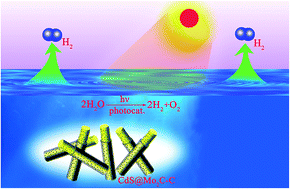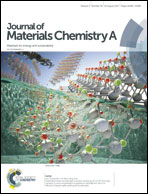Efficient visible-light-driven hydrogen generation from water splitting catalyzed by highly stable CdS@Mo2C–C core–shell nanorods†
Abstract
Sunlight-driven water splitting using light-absorbing semiconductor-based materials is an ongoing strategy to overcome the world-wide environmental pollution and energy crisis. The construction of core–shell-type nanostructures by coupling of the earth-abundant hydrogen generation catalyst Mo2C to the good photoabsorber CdS may be the best combination for photocatalytic hydrogen generation reaction. Thus, in this work, core–shell nanorods consisting of a CdS core and a Mo2C–C shell have been designed and synthesized for the first time. The as-prepared CdS@Mo2C–C nanorods display an excellent hydrogen generation rate of 17.24 mmol h−1 g−1 relative to pure CdS, which may result from the unique one-dimensional nanostructure, the strong interfacial interaction between the core and shell materials, as well as the broadened visible-light absorption range. What's more, the existence of C layers in the core–shell nanorods can facilitate transfer of the photogenerated holes to the outer shell of Mo2C–C, and thus protect the inner CdS from photocorrosion to finally achieve high photostability of the catalyst.



 Please wait while we load your content...
Please wait while we load your content...